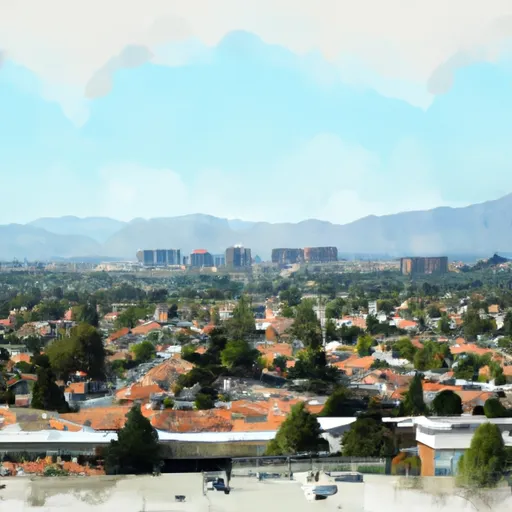-
 Snoflo Premium
Snoflo Premium
Get unlimited access to all our content
With no Ad interruptions! - Start Your Free Trial Login with existing account
Moreno-Valley
Eden Index
Climate
8.7
•
Recreation
5.4
•
Community
2.1
•
Safeguard
5.9/10

Moreno Valley is a city located in Riverside County, California. The climate in Moreno Valley is typically warm and semi-arid, with hot summers and mild winters. Average temperatures range from around 45°F (7°C) in winter to 95°F (35°C) in summer. The area receives limited rainfall, usually less than 13 inches per year.
As for hydrology constituents, Moreno Valley is part of the Santa Ana River watershed. The Santa Ana River flows through the city, providing a vital water source for the region. The area also contains several small creeks and tributaries.
Outdoor recreation opportunities in Moreno Valley are plentiful. The city has numerous parks and open spaces, offering opportunities for picnicking, hiking, and sports. Box Springs Mountain Reserve, located on the city's northern border, provides excellent hiking and wildlife viewing opportunities. The Lake Perris State Recreation Area, just east of Moreno Valley, is a popular destination for boating, fishing, camping, and hiking.
In summary, Moreno Valley features a warm and semi-arid climate, with limited rainfall. The city is surrounded by natural beauty, including the Santa Ana River, small creeks, and nearby parks and reserves, offering ample opportunities for outdoor recreation.
What is the Eden Index?
The Snoflo Eden Index serves as a comprehensive rating system for regions, evaluating their desirability through a holistic assessment of climate health, outdoor recreation opportunities, and natural disaster risk, acknowledging the profound impact of these factors on livability and well-being.
Climate Health Indicator (CHI): 8.7
Moreno-Valley receives approximately
261mm of rain per year,
with humidity levels near 75%
and air temperatures averaging around
18°C.
Moreno-Valley has a plant hardyness factor of
9, meaning
plants and agriculture in this region tend to thrive here all year round.
By considering the ideal temperature range, reliable water supplies, clean air, and stable seasonal rain or snowpacks, the Climate Health Indicator (CHI) underscores the significance of a healthy climate as the foundation for quality living.
A healthy climate is paramount for ensuring a high quality of life and livability in a region, fostering both physical well-being and environmental harmony. This can be characterized by ideal temperatures, reliable access to water supplies, clean air, and consistent seasonal rain or snowpacks.
Weather Forecast
Streamflow Conditions
Santa Ana
Area Rivers
Santa Ana
Snowpack Depths
Santa Ana
Reservoir Storage Capacity
Santa Ana
Groundwater Levels
Recreational Opportunity Index (ROI): 5.4
The Recreational Opportunity Index (ROI) recognizes the value of outdoor recreational options, such as parks, hiking trails, camping sites, and fishing spots, while acknowledging that climate plays a pivotal role in ensuring the comfort and consistency of these experiences.
Access to outdoor recreational opportunities, encompassing activities such as parks, hiking, camping, and fishing, is crucial for overall well-being, and the climate plays a pivotal role in enabling and enhancing these experiences, ensuring that individuals can engage in nature-based activities comfortably and consistently.
Camping Areas
| Campground | Campsites | Reservations | Toilets | Showers | Elevation |
|---|---|---|---|---|---|
| Lake Skinner | None | 1,514 ft | |||
| Rancho Jurupa Park | 67 | 751 ft | |||
| El Cariso | 24 | 2,568 ft | |||
| Yucaipa Regional Park | 51 | 2,658 ft | |||
| Wildomar | 11 | 2,456 ft | |||
| Glen Helen Regional Park | 47 | 1,993 ft | |||
| Upper San Juan | 18 | 1,761 ft | |||
| Lake Elsinore | 400 | 1,286 ft | |||
| Lake Perris State Rec Area | 351 | 1,600 ft | |||
| March ARB Military | None | 1,509 ft |
Catastrophe Safeguard Index (CSI):
The Catastrophe Safeguard Index (CSI) recognizes that natural disaster risk, encompassing floods, fires, hurricanes, and tornadoes, can drastically affect safety and the overall appeal of an area.
The level of natural disaster risk in a region significantly affects safety and the overall livability, with climate change amplifying these risks by potentially increasing the frequency and intensity of events like floods, fires, hurricanes, and tornadoes, thereby posing substantial challenges to community resilience and well-being.
Community Resilience Indicator (CRI): 2.1
The Community Resilience Indicator (CRI) recognizes that education, healthcare, and socioeconomics are crucial to the well-being of a region. The CRI acknowledges the profound impact of these elements on residents' overall quality of life. By evaluating educational resources, healthcare accessibility, and economic inclusivity, the index captures the essential aspects that contribute to a thriving community, fostering resident satisfaction, equity, and social cohesion.

